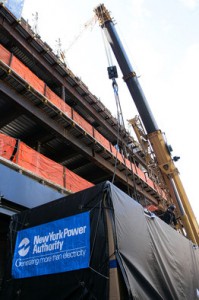The idea of relying more on distributed generation sources located at the point of power consumption is an idea that to most people is mainly associated with solar photovoltaic (PV) technologies, particularly in California, home of more than 60% of the nation’s solar PV.
But fuel cells — a distributed generation technology that can run on a variety of fuels and which can provide steady 24/7 power — has lagged behind solar PV as well as small wind turbines. A high profile installation of fuel cells at the World Trade Center, however, may help generate new interest among policy makers and investors for a technology that has long been hyped as part of the hydrogen economy. The fuel cells are one example of ways to boost energy efficiency and reduce the environmental impacts of power generation.

New Fuel Cells to Power Rebuilt WTC Towers
A key advantage of fuel cells, solar PV and small wind turbines is that they produce clean power on site without the need to build transmission lines, which often face delays. However there is no single silver bullet solution to all of our collective carbon reduction and economic development needs. Meeting those will also require increased reliance upon both large-scale bulk renewable energy plants, such as off-shore wind off the Atlantic Coast and Concentrated Solar Power plants in the southwestern deserts of California, Arizona and Nevada. (please see the previous blog post). Yet self-generation by large consumers will play an increasingly important role.
Another high-profile fuel cell application in Chino, California shows that these generators can also run on renewable fuels such as biogas, and contribute greatly to cleaning up the CO2 from farm animal waste. FuelCell Energy’s recently-announced 2.8 MW installation for the Inland Empire Utilites Agency is the largest of its kind to be installed at a wastewater treatment plant.
While hydrogen was once seen as a promising alternative fuel solution to our energy challenges, since it can be used to generate both electricity and serve as a liquid transportation fuel, California’s efforts to develop hydrogen infrastructure have fallen behind schedule, and the strategy once seen as a key initiative of outgoing Gov. Schwarzenegger is being reconsidered. Fuel cells appear to be the best fit for hydrogen. Along with stationary applications such as this current project at the World Trade Center and at the wastewater treatment facility in the Inland Empire, hydrogen could still play a role in cleaning up the transportation sector. As of late, however, there has been greater interest among investors and inventors have recently focused on plug-in electric hybrids. These cleaner hybrid electric cars would not only clean up California’s carbon emissions in the transportation sector — the source of 40% of California’s carbon footprint, according to the California Air Resources Board – but could also be used as storage devices to provide services to both homeowners and the larger electric grid.


